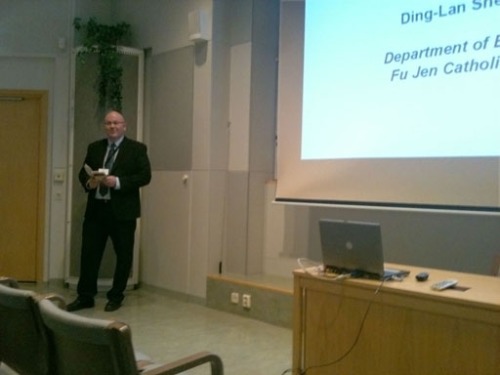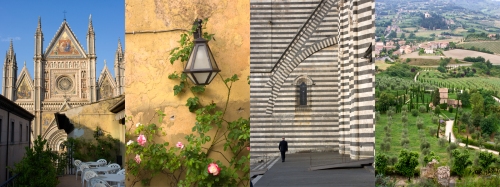So, I’m back from ECCTD 2011 since late Wednesday, and up here at the southern edge of the northern half of Sweden, the mornings are misty and the leaves are turning yellow. Visiting Linköping was every bit as pleasant as I had expected. The conference was held at Linköping Konsert & Kongress, which is beautifully located at the center of the city, right next to the Linköping Cathedral.
The conference
The conference was excellently organized by the Electronics Systems division at Linköping University and the conference committee. I was particularly impressed with the student helpers. Not only were they helpful, kind and attentive, but quite a few of them also turned out to be passionate about data-converter research and development [one of the healthier states of the human mind, BTW 😉 ] and we had several interesting conversations on the topic. I couldn’t possibly have felt more welcome.
After we all had been welcomed by the conference general chair, prof. Lars Wanhammar, Linköping University, the conference started with a plenary presentation “Managing Variability for Ultimate Energy Efficiency” given by prof. Borivoje Nikolić from UC Berkeley, USA. The conference then split up into various sessions which are described in detail in the program. ECCTD is a rather broad conference, but there were at least three dedicated data-converter sessions: “Sigma-Delta Modulators“, “Data Converters“, and “Pipelined ADCs“. I had the honor of chairing “Pipelined ADCs“, and I presented my own contribution “Area Efficiency of ADC Architectures” in the “Data Converters” session. I might come back to the content of that paper in another post, but in short (for those of you that were not there), it surveys the chip area vs. performance in speed and resolution for just about every ADC implementation reported in the scientific literature all the way since 1974 – approximately 1500 papers. A normalized area measure
was proposed based on the observed correlation between absolute chip area (A) and effective resolution (ENOB). State-of-the-art AQ – a.k.a. “Area per effective quantization step” – was seen to be independent not only of ENOB, but also of sampling rate over a broad range of sampling rates and resolutions, respectively. It is also approximately independent of CMOS process node. Chip area per effective quantization step was then compared for individual architectures, and design guidelines derived for area-optimal ADC architecture selection at any given speed and resolution specification. It was seen that there are large differences in the peak area efficiency achieved with different ADC architectures. There is for example a factor of 3 difference between SAR and pipeline, and a factor of 10 between pipeline and flash. Such big area differences can translate to a lot of money if you’re developing high-volume ADCs. So make sure you get hold of this paper as soon as it comes up on IEEE Xplore.
Professor Mark Vesterbacka, Linköping University had to push the electronics in his mobile phone to the maximum in order to document my chairing efforts in spite of the low light. Thanks for sending the picture.
CWCP winner
I could notice a slight peak in blog visitors yesterday. I assume that many of you wanted to know who won the Connect-with-Converter Passion (CWCP) prize, and I apologize for not being as fast as Dr. J Jacob Wikner who was blogging live from ECCTD and managed to fire away several conference-related post on Mixed-Signal Electronics while ECCTD was still developing. One of them correctly revealing that we had a CWCP winner already after the first day. And the winner is:
Kiran Kariyannawar from Ericsson AB, who showed the enthusiasm and dedication necessary to win the CWCP prize for ECCTD. Congratulations Kiran! Kiran was there together with other Ericsson colleagues to demonstrate The Connected Tree and how to transmit audio and video signals through the human body. Quite far out compared to most demonstrations I’ve seen at scientific conferences. Very fun (at lest from a tech nerd’s perspective), and I’m sure they will figure out a lot of applications for it eventually, although for now they didn’t seem quite sure what to do with it. At least not with the connected tree. I played a bit with the human-body transmission (by becoming the channel), and I think it could be great for DJ-ing. I was just about to get it to rock big time when I started to realize the other delegates need for less noise and gave it up. If only I had a few more minutes to work out that groove …

The next big thing in DJ-ing? Just intermittently add a human body connected between those metal plates – preferably in a rhythmic pattern – and you're all set.
Other impressions
The conference dinner was held at the Air Force Museum – a place I’m likely to return to again to have more time to look at everything. Most likely with the rest of the family. A few photos below will give you some idea of the location. Finding unorthodox locations that can make the conference dinner extra memorable is probably a real challenge to most organizers. Unless they start taking us to outer space and back, I believe that the abundant food stations in combination with the breathtaking beauty of sea life shown at Monterey Bay Aquarium (ISCAS 1998) will remain my personal favorite for the rest of my life, but with ECCTD 2011 now being among the top two. Excellent work!

A missile of some kind, with a sign in Swedish saying "DO NOT PUSH HERE". Now, how irresistible is that on a scale to ten? Photo: M. Reza Sadeghifar
Having been to a few conferences, you start to recognize some faces that keep coming back. I had the pleasure of meeting delegates I’ve recently met. Some at NORCHIP, some at ICECS, and others at IWADC. It was great seeing you all. That is the real value of going to conferences.
Peace!






















